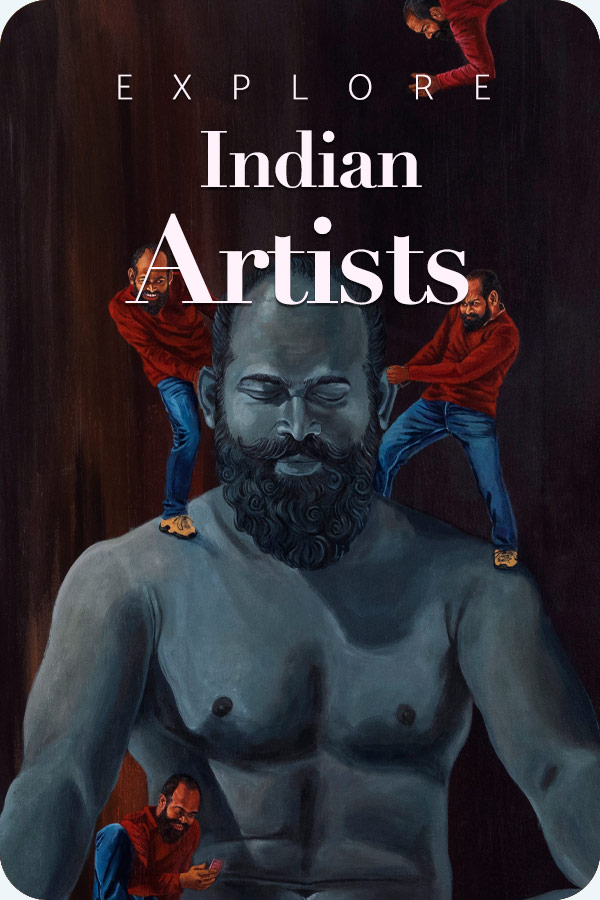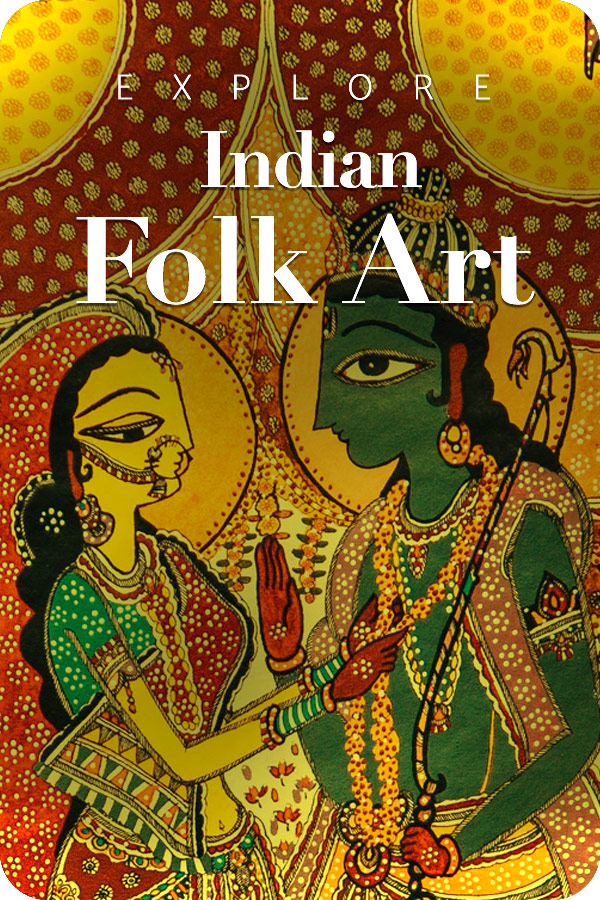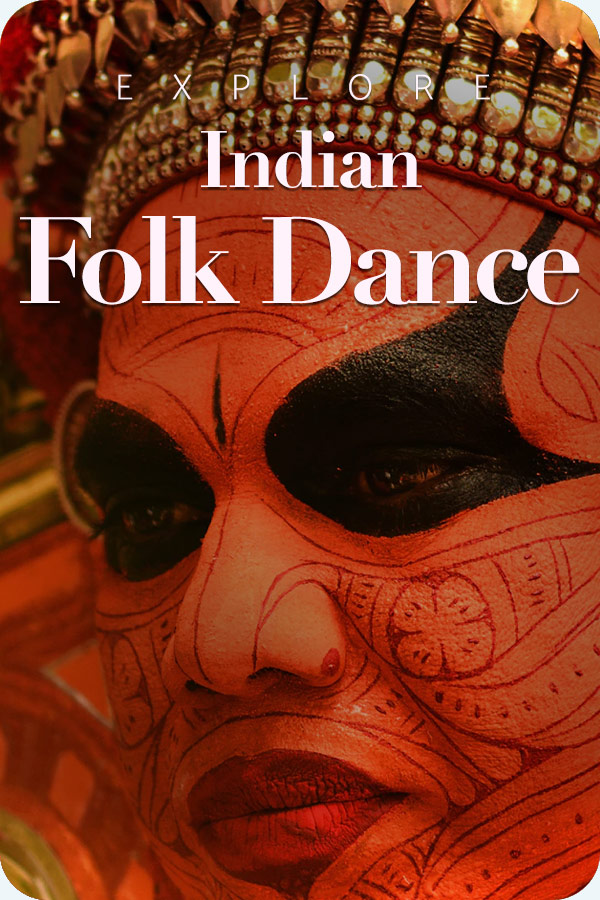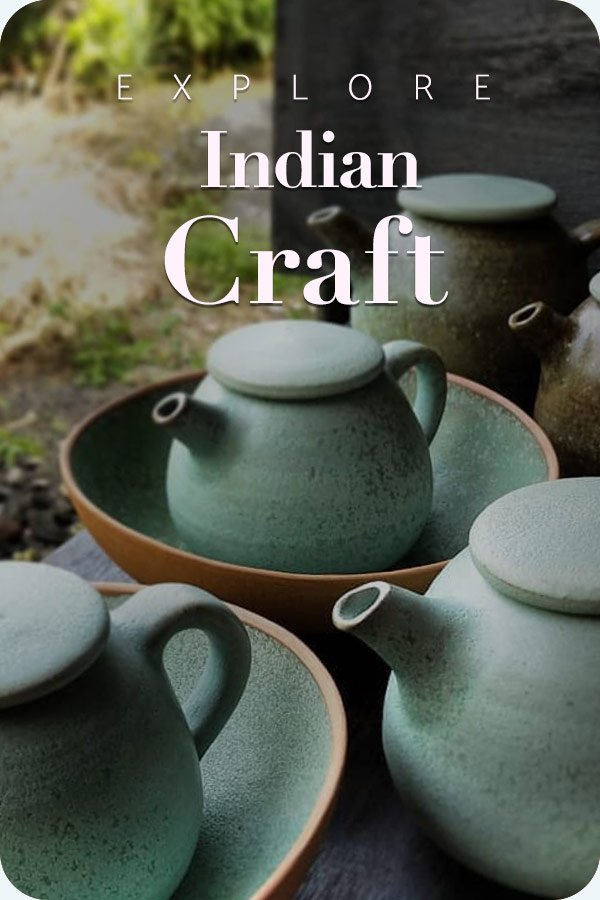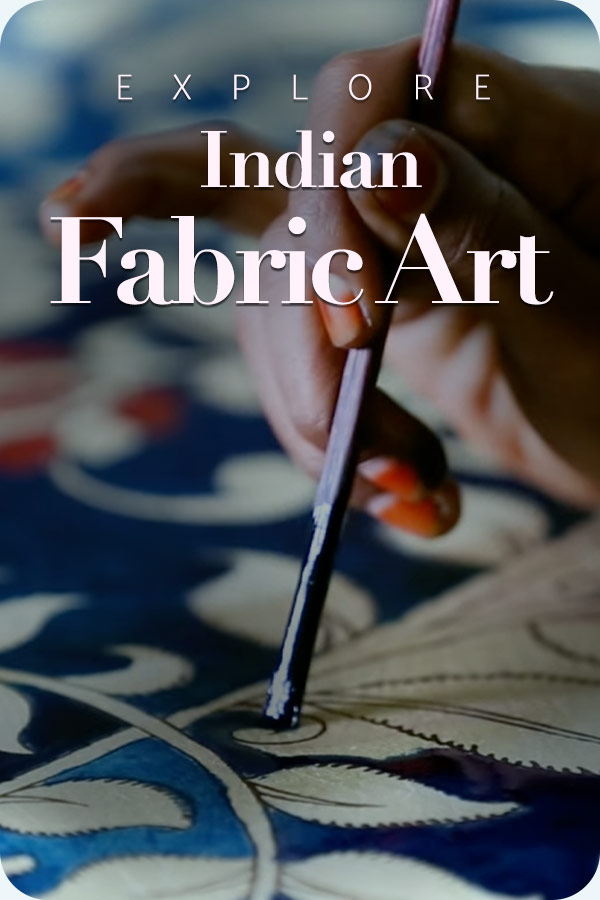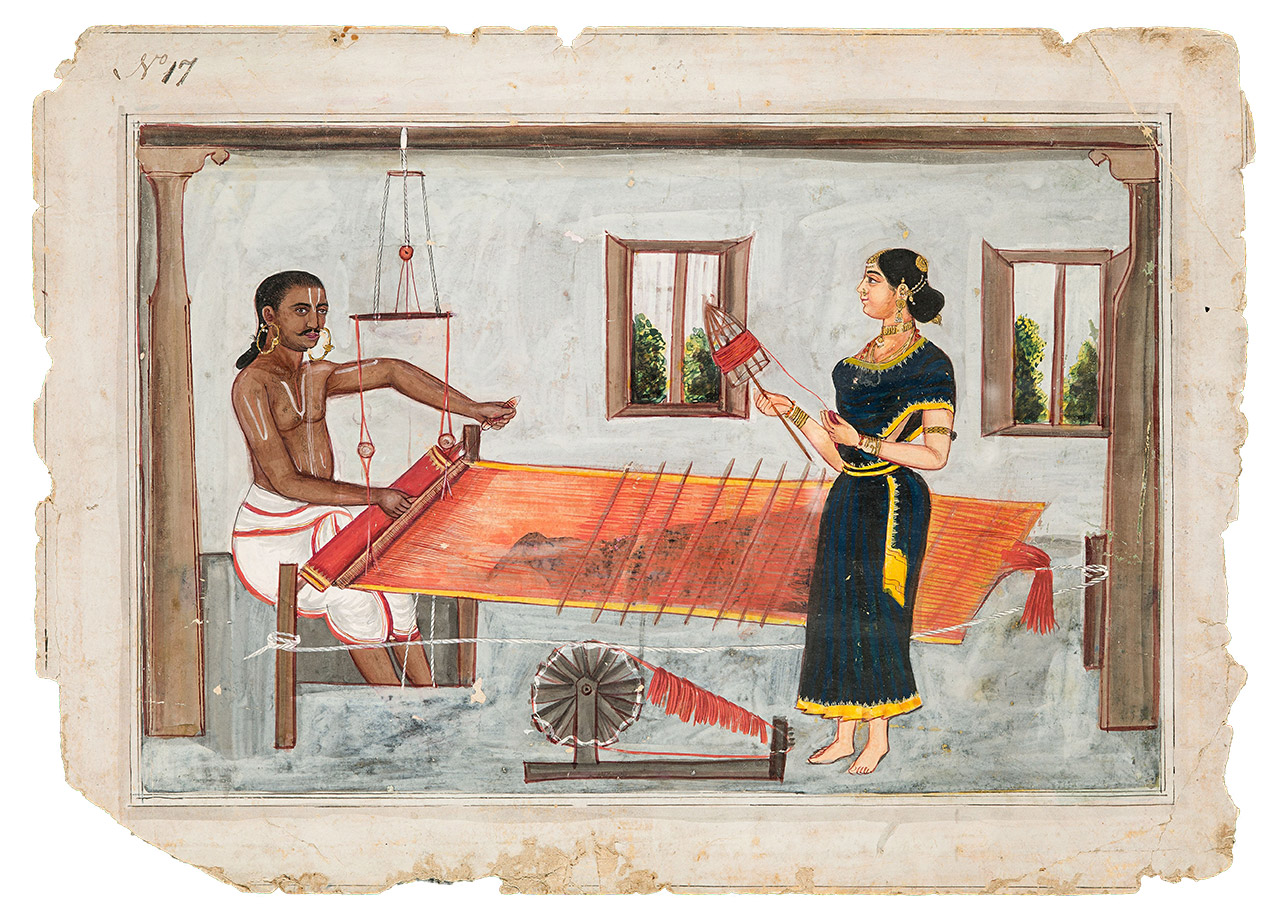
Handlooms of India Interactive Map
What is the Signficance of Indian handlooms?
Handlooms of India represent the vast cultural diversity of the whole nation. From the intricate designs of Banaras, to the rustic weaves of Assam, the handlooms of India represent diverse communities and histories. It employs millions of craftsmen, particularly in the rural regions, emerging as a cornerstone of economic vitality as well. The handloom sector is a cornerstone of India’s cultural legacy, reflecting the distinctive cultures of different regions across the subcontinent.
Suggested Read – 12 Best Websites to Buy Handloom Sarees this Festive Season
History of Indian Handlooms
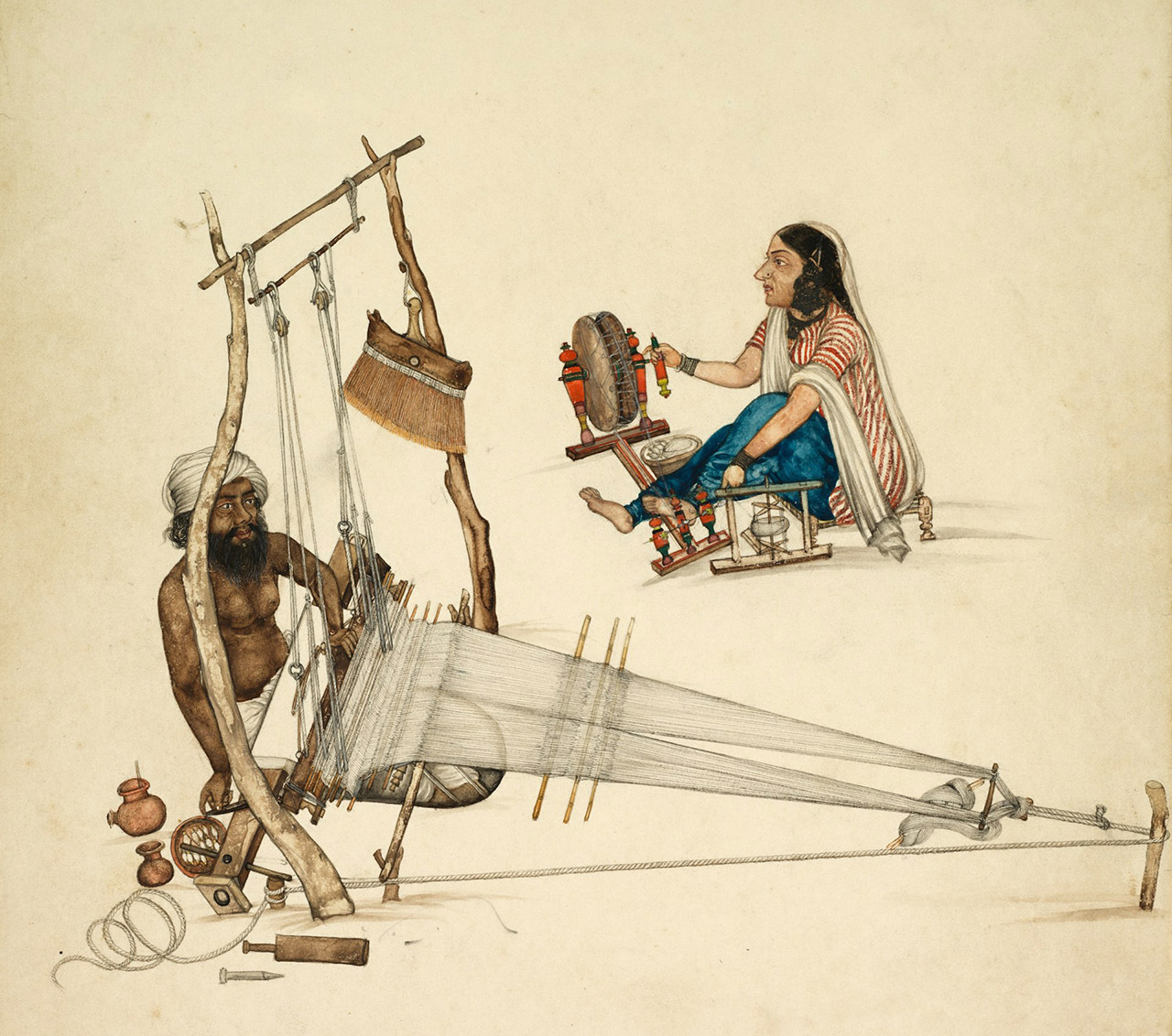
Pre-Independence
- Ancient Period: The history of the Indian handloom dates back as far as 3000 BCE, with the first evidence being found from the Indus Valley Civilisation. This is backed by archaeological findings of spindles and whorls from Harappan sites.
- Medieval Period: The medieval period witnessed the peak of Indian handlooms, and India was also involved in the far-reaching trade of textiles across distant lands of China, Rome, and Europe. Indian muslin, silk, and cotton exports made India a global textile hub.
- Colonial Period: The 19th century witnessed the decline of handlooms with the introduction of the industrial looms by the British. However, the Indian Handloom became associated with culture and identity during the late colonial period, with the Swadeshi movement boosting the revival of indigenous weaving. Further, Mahatma Gandhi’s Khadi campaign played a crucial role in promoting Indian Independence and self-reliance.
Post-Independence
- Phase of Decline: In the post-independence era, Indian Handlooms emerged as one of the largest rural employment sectors. With the emergence of power looms and globalisation, the handlooms tradition witnessed a decline during 1990s.
- Revival Stage: The revival of the handlooms was initiated by MGNREGA in 2006, and promoted directly under the National Handloom Policy (2007) introduced by the then Prime Minister Manmohan Singh.
- Current Scenario: Presently, the 4th All India Handloom Census records the presence of over 2.73 lakh handloom weavers and 8.48 lakh allied workers around the country.
List of Handlooms of India State-wise
Click here to view the Handlooms of India List
| State & Handloom (GI Tag Year, if available) |
Speciality & Historical Significance |
|---|---|
| Andhra Pradesh – Kalamkari GI Tag: 2009 |
Painted and block-printed with natural dyes; tells stories through fabric using pen and tamarind ink. |
| Arunachal Pradesh – Apatani Weave Not GI Tagged |
Woven by Apatani women using organic cotton; known for stripes, zigzags, and earthy tones; passed down through generations. |
| Assam – Muga Silk GI Tag: 2007 |
Rare golden silk from Assam, worn by Ahom royalty; durable and naturally glossy. |
| Bihar – Bhagalpuri Silk GI Tag: 2009 |
Also called ‘Tussar silk’; produced in Bhagalpur for over 200 years; known for natural sheen and breathable texture. |
| Chhattisgarh – Kosa Silk Not GI Tagged |
Tussar silk woven from silkworms feeding on sal leaves; earthy, textured, and strong. |
| Goa – Kunbi Not GI Tagged |
Simple, red check-patterned saree worn by Goan tribal women, predating Portuguese influence. |
| Gujarat – Patan Patola GI Tag: 2003 |
Double ikat weave with intricate symmetry on both sides; takes months to complete. |
| Haryana – Panja Durries GI Tag: 2008 |
Flat-woven rugs using ‘panja’ tool; feature geometric and floral patterns; handmade by rural women in Panipat. |
| Himachal Pradesh – Kullu Shawls GI Tag: 2005 |
Woolen shawls with geometric patterns; warm and culturally rich accessory from the hills. |
| Jharkhand – Kuchai Silk GI Tag: 2008 |
A variety of Tussar silk grown in Kuchai; GI-tagged; supports tribal women and sustainable sericulture practices. |
| Jammu & Kashmir – Pashmina GI Tag: 2005 |
Pashmina, often called the “soft gold” of Kashmir, is a luxurious handwoven wool known for its exceptional warmth, softness, and timeless elegance. |
| Karnataka – Mysore Silk GI Tag: 2005 |
Silk of royal origin, introduced by Tipu Sultan; known for its purity and rich gold borders. |
| Kerala – Kasavu Not GI Tagged |
Off-white handwoven cotton fabric with rich gold zari borders; worn during Onam and weddings; symbol of purity and tradition. |
| Madhya Pradesh – Chanderi GI Tag: 2005 |
Delicate and translucent sarees woven with silk and zari, known for lightness and elegance. |
| Maharashtra – Paithani GI Tag: 2010 |
Known for its peacock motifs and rich zari, Paithani is a royal silk weave from Aurangabad, once reserved for Maratha nobility. |
| Manipur – Phanek Not GI Tagged |
A traditional wraparound skirt worn by Meitei women, often seen in bold colours or vertical stripes, it represents cultural pride and personal identity. |
| Meghalaya – Eri Silk GI Tag: 2011 |
Also called Ahimsa silk; produced without harming the silkworm. Known for warmth, softness, and eco-friendly production. |
| Mizoram – Puan GI Tag: 2014 |
Woven wrap skirt with bold horizontal bands; worn during Mizo festivals and dances; important marker of tribal identity. |
| Nagaland – Naga Shawls GI Tag: 2008 |
Woven on loin looms with bold stripes and tribal motifs like mithun; worn to denote clan, status or achievements. |
| Odisha – Bomkai GI Tag: 2009 |
Features temple, tortoise, and lotus motifs with intricate threadwork; culturally rooted. |
| Odisha – Sambalpuri GI Tag: 2005 |
Bandha (ikat) dyed sarees with conch, wheel, and flower motifs; deeply tied to Odia culture and rituals. |
| Punjab – Phulkari GI Tag: 2011 |
Floral embroidery on coarse cotton with vibrant silk threads; traditionally made by Punjabi women for weddings and festivals. |
| Rajasthan – Bandhani GI Tag: 2009 |
Traditional tie-dye technique involving thousands of knots; vibrant and symbolic, often used for festive attire. |
| Rajasthan – Shisha (Mirror Work) Not GI Tagged |
Traditional embroidery using mirrors stitched into fabric; believed to reflect evil spirits. Common in tribal and festive garments. |
| Sikkim – Lepcha Weave Not GI Tagged |
Backstrap loom weaving by Lepcha tribe; fabrics feature narrow stripes and hold cultural significance during rituals and ceremonies. |
| Tamil Nadu – Kanjeevaram GI Tag: 2006 |
Heavy silk sarees with bold temple motifs; worn at weddings and major celebrations. |
| Telangana – Pochampally GI Tag: 2005 |
Famous for geometric double ikat patterns; known globally for its design clarity. |
| Tripura – Pachra Not GI Tagged |
Traditional lower garment of Tripuri women; handwoven with colourful stripes and patterns; worn during festivals and dances. |
| Uttar Pradesh – Banarasi Silk GI Tag: 2009 |
Regal brocade sarees with Mughal-inspired zari motifs; often heirloom pieces. |
| Uttar Pradesh – Chikankari GI Tag: 2008 |
Delicate embroidery from Lucknow with Mughal roots; features floral patterns stitched with white thread on soft fabric. |
| Uttarakhand – Panchachuli Weave Not GI Tagged |
Women-led weaving cooperative from Kumaon region; uses wool from local sheep to make shawls with stripes and mountain motifs. |
| West Bengal – Baluchari GI Tag: 2009 |
Mythological tales are woven into pallus; iconic from Bishnupur and Murshidabad. |
| West Bengal – Jamdani GI Tag: 2010 |
Fine muslin with extra weft motifs like paisleys and vines; a UNESCO-recognised weaving tradition with Mughal legacy. |
1. Andhra Pradesh

Andhra Pradesh is the state with the most famous textiles and is known for its intricate work. It is a hub for traditional weaves with more than 3,00,000 handloom weavers in the state, including both, the ones within the cooperative fold, and out of the same.
Kalamkari
The name of “Kalamkari” hand/block printed cotton textile originates from the Persian words- ‘qalam’ (pen), and ‘kari’ (craftmanship). This involves a long seventeen-step procedure including natural dyeing, hand-painting and block-printing
Kalamkari Styles: There are two distinctive styles:
- Srikalahasti style: It involves freehand drawing. The motifs depict mythological and religious themes.
- Machilipatnam style: It involves block printing. Persian influence is reflected in the floral and geometric motifs.
Dharmavaram & Uppada Silks
The Dharmavaram silk fabric came to prominence about a century ago, particularly in the town of Dharmavaram, in Anantapur district of Ralaseema region. Uppada Silk originates from the beach town of Uppada, and is renowned for its Jamdani weaving technique, which is in demand across the globe. The sarees have subtle dual tone colours, soft texture, and simple designs. These are known for broad borders and pallus with gold brocade embroidery.
Dharmavaram Silk
- Motifs: Broad borders with temple designs, floral buttas, and peacock or elephant motifs enriched with zari.
- Colour Palette: Rich dual shades like crimson & green, maroon & mustard, or purple & gold, giving a lustrous effect.
Uppada Silk (Jamdani)
- Motifs: Delicate Jamdani floral motifs, geometric patterns, and buttas woven directly into the fabric.
- Colour Palette: Lightweight pastels like peach, sky blue, and cream contrasted with bright borders in gold or silver zari.
Mangalagiri and Venkatagiri Soft Cotton
The Mangalagiri and Venkatagiri soft cotton sarees are primarily in contant trend for their lightweightm and soft feel. The sarees are predominantly made by cotton-silk blend, employing the Jamdani weaving technique for designs. These sarees are known for a distinctive ‘nizam border’, and striped pallu.
Mangalagiri Cotton
- Motifs: Plain bodies with zari borders, temple designs, and Nizam-inspired geometric patterns.
- Colour Palette: Earthy shades like mustard, maroon, green, and off-white with contrasting zari highlights.
Venkatagiri Cotton
- Motifs: Floral buttas, peacocks, and creeper designs woven with fine zari on a soft cotton base.
- Colour Palette: Pastel shades like ivory, beige, and light pink balanced with bright tones and silver-gold zari borders.
2. Arunachal Pradesh

The handlooms of Arunachal Pradesh are known for their vibrant cultural traditions, associated with several tribes like the Apatani tribe, Monpa tribe, Mishmi tribe, and particularly, the Adi and Nyishi tribes.
Apatani Weave
It is associated with the Apatani tribe of Ziro Valley, and unlike most of the traditional handlooms across the country, rather than just being adorned during festivals and wedding ceremonies, the Apatani weave is a part of the daily wardrobe of the community. Bamboo plays a crucial role. The design loops are formed using a bamboo frame, and the main weaving procedure is also done using bamboo tools.
- Motifs: Geometric and zigzag patterns
- Colour Palette: The palette comprises primarily of black, red, yellow, blue, and orange colours. The craftsmen use leaves and other natural resources to dye the yarn.
- GI Status: Awarded in 2021
3. Assam

Assam is a major silk producer, not only in India but worldwide. The most popular handlooms include Muga, Eri, and Pat silks. The state of Assam is leading the Indian Handlooms Sector, with the maximum number of people employed in weaving.
Muga Silk
It is known as the ‘golden silk’ and is sourced from the wild silkworm Antheaea assamensis. The fabric is a natural golden-yellow sheen and is known for durability, warmth, and humidity absorption. It was under the patronage of the Ahom dynasty during the 13th century AD.
- Motifs: Gos-buta, kolka, kinship, and tribal patterns.
- Colour Palette: Muga silk known for its natural golden-yellow sheen that deepens with age, often paired with red, green, or black borders.
- GI Status: Muga Silk was given the GI tag in 2007.
Eri Silk
Eri Silk is an eco-friendly silk produced and hence is also known as ‘ahimsa silk’. It is sourced from the Samia Ricini silkworm. No silkworm is harmed or killed during the production of this silk. The fabric is coarse, durable, dense, and elastic. It is known for its rustic look. The entire process is natural, and eco-friendly. The dyes are also produced naturally.
- Motifs: Eri silk often carries traditional tribal motifs like stripes, checks, floral patterns, and symbolic geometrical designs.
- Colour Palette: Naturally found in off-white and cream shades, it is also dyed into earthy tones like beige, rust, red, and deep green.
4. Bihar

Bihar has over 3.66 lakh weavers across 77,000 looms, making it a crucial state for the national handloom sector. The legacy of handloom in Bihar is centred around the town of Bhagalpur. The city is known as the ‘Silk City’.
Bhagalpuri Silk
Bhagalpuri silk, often referred to as “Tussar silk,” is woven in Bhagalpur, Bihar—one of India’s oldest silk hubs with over 200 years of heritage. The colourful dyed silk threads used to weave the Bhagalpuri silk sarees are produced from tussar cocoons, natively found in Bhagalpur and Banka. It is known for its soft fabric, natural sheen, and durable nature.
- Motifs: Floral, geometric, tribal motifs, often adorned with extra-weft patterns
- Colour Palette: Red, blue, pink, orange, and gold.
- GI Status: Awarded in 2013
Bawan Buti
Bawan Buti hails from Nalanda, adorning the Buddhist tradition in craftsmanship. The handloom is known for its intricate motifs, representing the Buddhist influence. These are Lightweight in nature, ideally worn as a daily-wear.
- Motifs: Has about 52 miniature motifs, including Bodhi treem leaves, stupas, lotus, among other symbols associated with Buddhism
- Colour Palette: White, cream, pastel sarees with pallus in vibrant red, green, blue colours
5. Chhattisgarh
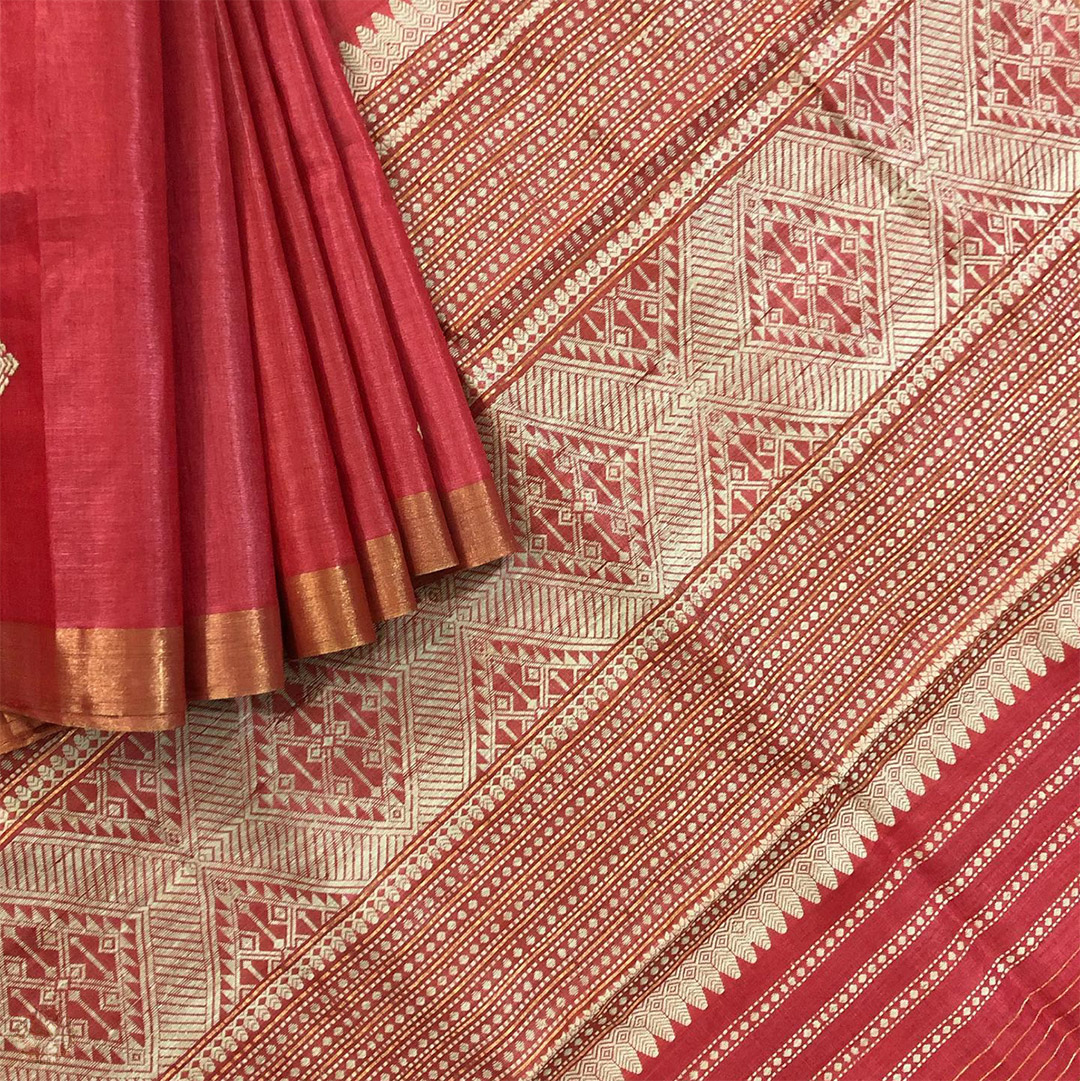
Chattisgarh is known for its rustic aesthetic. The Kora silk is the hallmark of the tribal and rural identity of Chattisgarh, and has contributed significantly to the cultural heritage of the state.
Kosa Silk
The Antheraea mylitta silkworm is the mail source of this Tussar silk. It is found natively in Champa, Raigarh, and Bilaspur. The sull golden sheen fabric is dyed naturally, using lac, haram or iron.
- Motifs: Tribal patterns, accompanied by rudraksha patterns and temple borders.
- Colour Palette: Known for natural shades of golden, cream, and brown, along with dyed hues like maroon, green, and deep blue.
- GI Status: Kosa Silk received the GI tag in 2006.
6. Goa

Goa is known for its small-scale, yet vibrant handloom tradition. The textiles of Goa reflect its indigenous coastal culture, and history. The textiles are known for their simplicity, but also show Portuguese influences.
Kunbi Saree
- Th Kunbi handloom is the oldest indigenous textile of Goa, associated with the Kunbi and Gawda communities. The sarees are characterised by red and white checkered patterns, intersected by slim horizontal lines. The border has minimal pattern, and the sarees were traditionally worn without a blouse or pallu.
- Motifs: Kunbi sarees are traditionally woven in simple checks and stripes, reflecting the agrarian lifestyle of the Kunbi tribe.
- Colour Palette: They usually feature earthy reds, maroons, and blacks, sometimes contrasted with white or mustard tones.
7. Gujarat
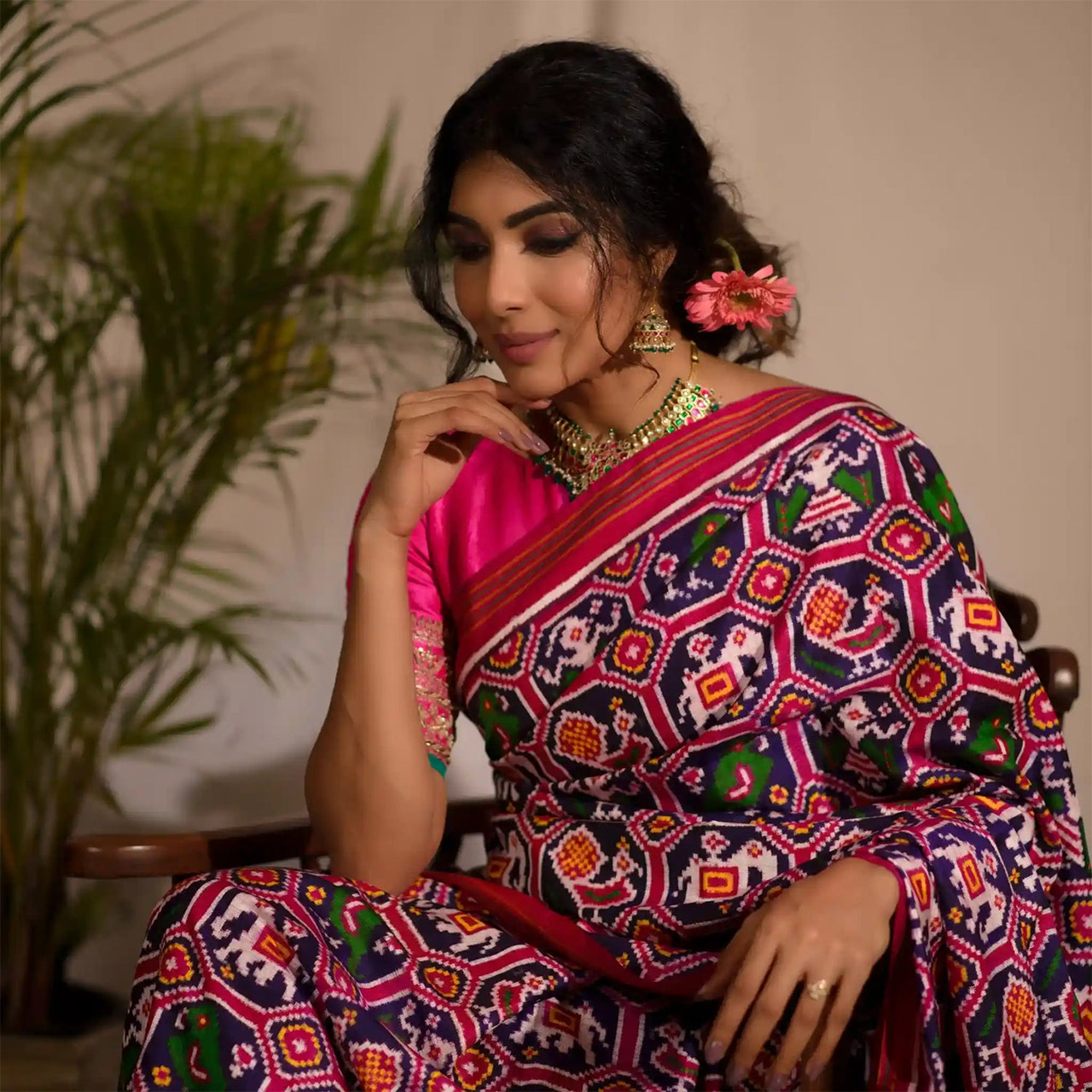
Gujarat is a hub for tie-and-dye techniques. It is known as the ‘Manchester of the East’, with its detailed and large-scale handloom tradition.
Patan Patola
Traditionally, Patan patola was adorned by the royal houses of Gujarat regions, and the Jains. The Salvi family of Patan has mastered and kept this double ikat silk weave in practice since the 11th century. These are known for their high-quality and engaging geometric patterns.
- Common Motifs: Floral, faunal, and figurative motifs
- Colour Palette: The combination of natural colours like red, indigo, green, and yellow.
- GI Status: It received the GI tag in 2013, and presently, very few families continue this art.
Bandhani
The name ‘Bandhani’ originates from the Sanskrit term ‘banda’, which means ‘to tie’. The handloom is primarily associated with the Khatri community of Gujarat, and is popular for its vibrant colours and white dots throughout the fabric. This tie-dye tradition dates back to the Indus Valley Civilisation and was even patronised by the Mughal emperors.
- Motifs: Dots, floral, geometric, and paisley designs.
- Colour Palette: Red, maroon, yellow, green, and blue
8. Haryana

The handloom tradition in Haryana is centred around Panipat and Rohtak, with about 8,000 looms, and 25,000 weavers.
Panja Durries
The handloom tradition of Panipat, Haryana, gets its name from the prime tool used in the weaving process, the panja. This handloom is made from thick threads to make durries and rugs featuring complicated patterns.
- Motifs: Floral motifs, accompanied with stripes or checks.
- Colour Palette: Red, blue, green, and beige.
9. Himachal Pradesh

Kullu and Kangra are the two main regions of Himachal Pradesh mastering the Himachali handlooms. These are significant not only for cultural identity, but also to support local livelihoods of the people.
Kullu Shawls
- The kullu shawls are prepared by the local artisans known as Kulivis, who use the traditional pit or frame looms for adding patterns to the textile. The trend of detailed designs in these shawls intensified with the influence of Bushahr craftsmen during the 1940s.
- Motifs: Geometric and floral patters, with twill-weave borders.
- Colour Palette: Red, blue, green, yellow, and black.
10. Jammu and Kashmir
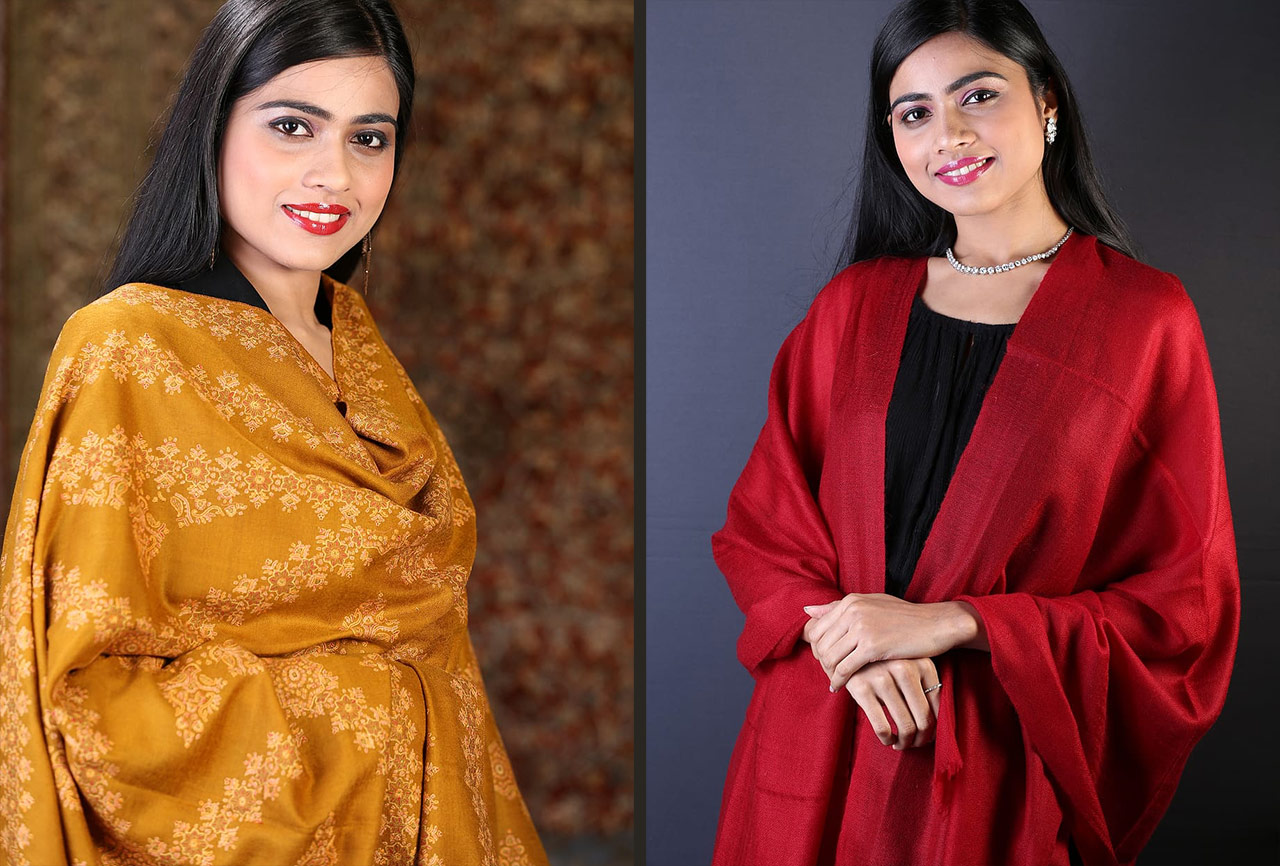
The handlooms of Jammu and Kashmir are popular worldwide, attracting tourists from different regions across the globe. These form the cornerstone of the cultural and regional identity, and economy of Jammu and Kashmir.
Pashmina
Pashmina is derived from Chagthangi goat fleece, and is known for iys softness and warmth globally. It is hand-embroidered, and is often rehgarded as a symbol of Kashmiri cultural heritage. Pashmina originated about 700 years ago and flourished during the Mughal period.
- Motifs: Floral, paisley patterns, with particular emphasis on chinar leaf designs.
- Colour Palette: Natural shades like white beige, brown, vibrant dyes like red, blue, and gold. Contrasting hues are selected for embroidery threads.
- GI Status: Awarded with GI tag in 2008
11. Jharkhand
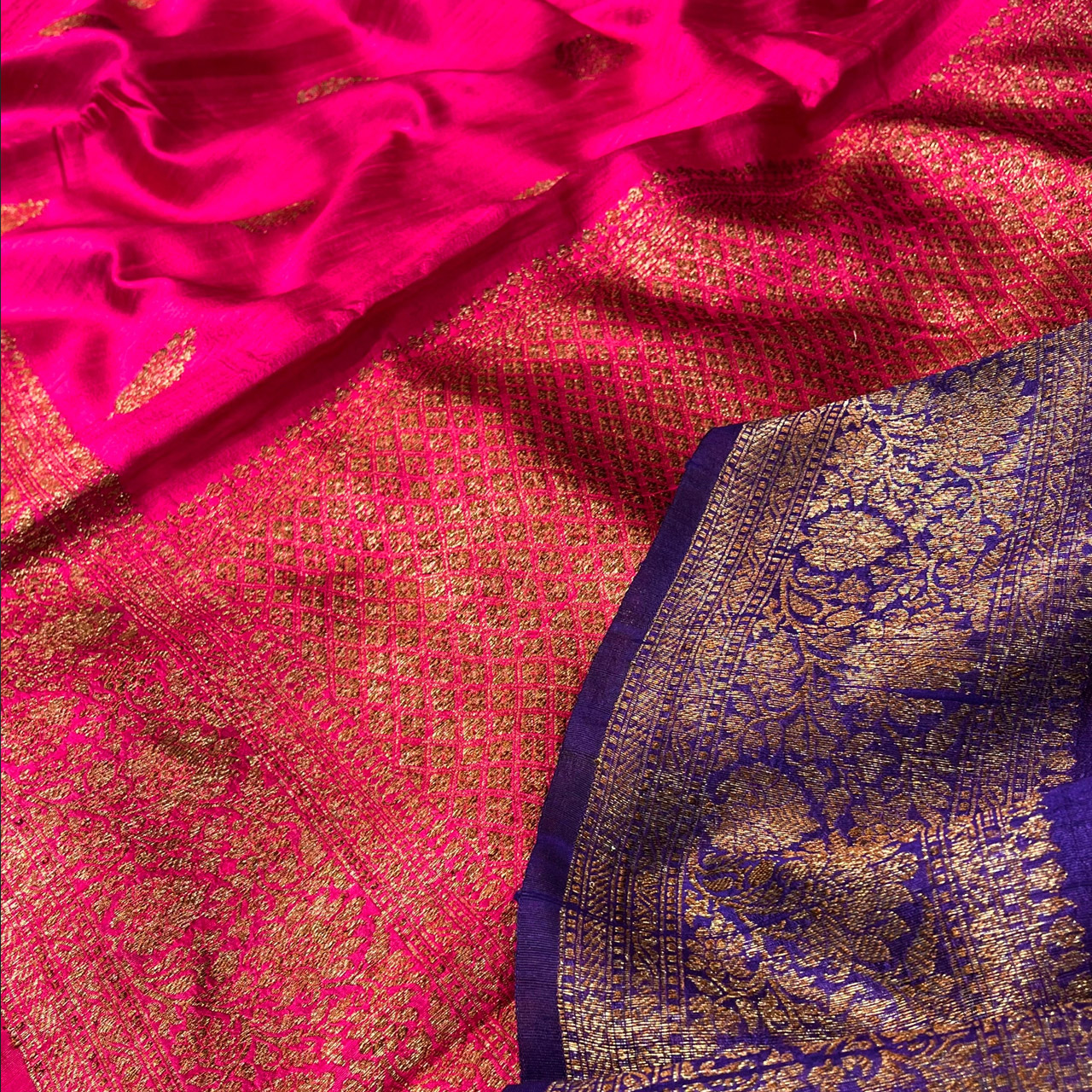
The handlooms of Jharkhand are characterised with organic Kuchai solk and tribal cotton weaves. The handloom sector in the state supports rural tribal communities, and particularly women, in creating a cultural identity.
Kuchai Silk
- This organic fabric is prepared primarily in the Kharsawan-Kuchai region, and is known for its eco-friendly production.
- Common Features: The fabric is lightweight, has coarse texture, and a rustic look.
- Motifs: Geometric and tribal motifs, particularly floral and rudraksha patterns.
- Colour Palette: Beige, brown, and golden yellow naturally. However, the fabric is often dyed with vibrant red, green, and blue colours, extracted from natural sources.
12. Karnataka

Karnataka is known as a major textile hub, contributing significantly to the exports of Indian handlooms.
Mysore Silk
Mysore Silk is known for its high sheen and rich cultural heritage, It is one of the most exported items of Kartnaka, contributing significantly to the economy of the state and the nation. Historically, the textile was encouraged and patronised by Tipu Sultan, and later the Wodeyar dynasty. It is made from pure mulberry silk and silver-gold zari.
- Motifs: Mysore Silk sarees feature minimalistic motifs such as mango, floral, peacock, and geometric patterns woven in zari.
- Colour Palette: They are known for rich, solid hues like red, green, blue, and mustard, highlighted with gleaming gold borders.
- GI Status: In 2005, it was awarded a GI tag and gained global recognition.
Ilkal Saree
- The Ilkal saree of the Bagalkot town is known for its unique tope teni technique. These cottin-silk blend sarees form the traditional attire of the region.
- Motifs: Stripes, checksum and temple borders.
- Colour Palette: Red, green, blue, and maroon.
- GI Status: Awarded with the GI tag in 2007
13. Kerala

Kerala handlooms, known for their simplicity and elegance, are traditionally woven in cotton with signature gold borders, as seen in the iconic Kasavu sarees. Rooted in heritage and eco-friendly practices, they symbolize purity, craftsmanship, and the cultural identity of God’s Own Country
Kasavu
The traditional off-white and gold bordered Kasavu saree is the epitome of the cultural tapestry of Kerala.This textile symbolizes purity and elegance in the Mallu culture.
- Motifs: These sarees have minimal designs with very few temple-inspired motifs or simple stripes.
- Colour Palette: Off-white or cream with golden or silver zari borders.
- GI Status: It was awarded with the GI tag in 2009, particularly for Balaramapuram Kasavu.
14. Madhya Pradesh

Madhya Pradesh is famous across the counrty for its silk and cotton sarees. This promotes not only the handloom industry in the state, but also the agriculture sector as cotton is a major commercial crop in Madhya Pradesh. The handlooms in the Malwa region were promoted under particularly under royal patronages of Baroda, Indore, Gwalior, and Nagpur. The two main handlooms include Chanderi and Maheshwari sarees.
Chanderi Fabric
- This dilk-cotton blend from Chanderi is known for its sheer texture and beautifully detailed zari work, reflecting royal elegance. The fabric originated under the Malwa rulers during the 14th century.
- Motifs: The dominant motifs include floral, and faunal motifs, particularly peacock depictions, and geometric patterns.
- Colour Palette: Soft pastel colours like pink, beige, and blue, accompanied by vibrant hues like red and golden.
- GI Status: Awarded with GI tag in 2005
Maheshwari
The cotton-silk blend Maheshwari sarees are renowned for their unique and reversible borders. The design of thse sarees is inspired by the forts of the Holkar dynasty. The fabric flourished under the royal patronage of Queen Ahilyabai Holkar during the 18th century. It was later revived by REHWA Society in the 20th century.
- Motifs: Motifs on Maheshwri sarees are often inspired by the maheshwar fort architecture, and includes stripes and checks.
- Colour Palette: Maroon, green, blue, and golden are primarily used.
- GI Status: The Maheshwari fabric got its GI tag in 2010.
15. Maharashtra

Maharashtra has a rich history of Sultanatesm Mughal emperors, Marathas, and Peshwas promoting and patronizing various crafts, and artisans. The state has a long list of handloom traditions associated with it, including Paithani, Sakapur Chadar, Ghondahi, Dhurrie, Narayan Pethi, Geneshpur-Kosa silk, Khana, Himroo, etc. Paithani is the most popular of these.
Paithani
This handloom is made of pure mulberry silk and gold/silver zari, representing the Maratha heritage and grandeur.
- Motifs: The textile is adorned with animal and floral motifs, showing inspiration from the Buddhist art.
- Colour Palette: The primary palette for the Paithani sarees includes bright colours like green, red, purple, and golden tones.
- GI Status: This is a GI-tagged craft work with only a few ikkar-type looms remaining in Yeola/Paithan.
16. Manipur
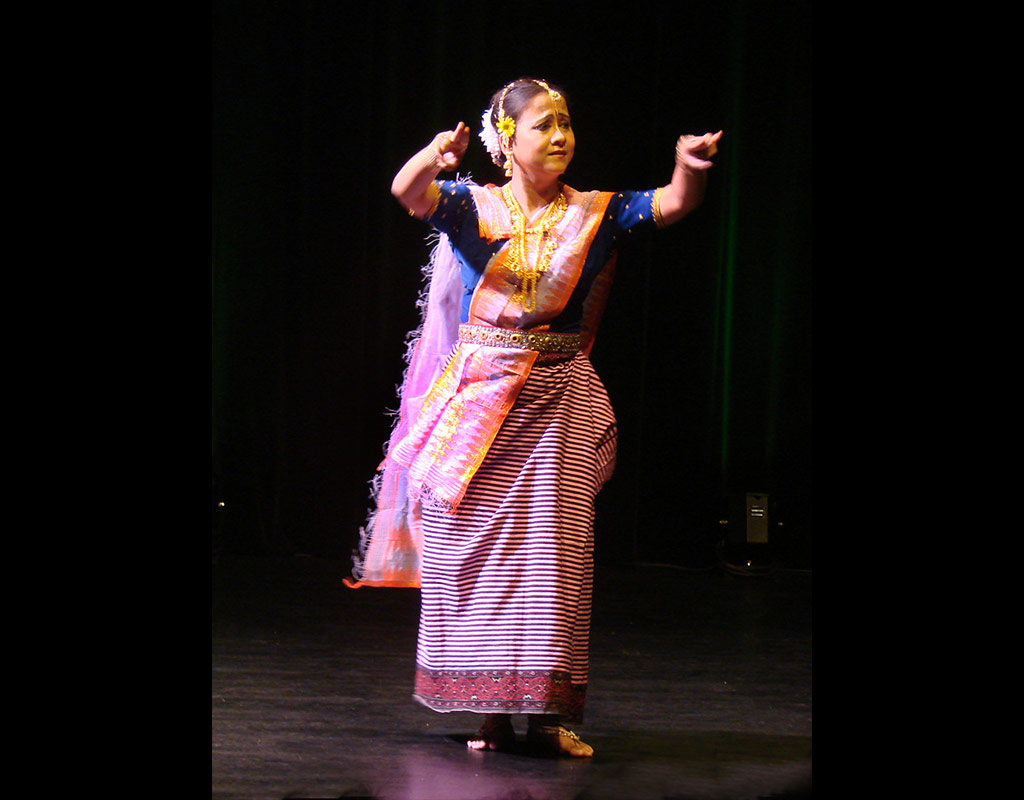
The handloom tradition of Manipur is centred in Imphal, and has over 2.5 lakh weavers. The industry is led by women, and aims at presevig the tribal heritage.
Phanek and Moirangphee
Phanek and Moirangphee forms the entire traditional attire of Manipuri communities. The Phanek is the skirt, while Moirangphee is the traditional shawl, wrapped around the upper body. These are made by the Meitei weaves. These are known for their bold patterns and unique border designs.
- Motifs: Phanek weaves often display intricate tribal motifs on the borders, crafted with extra-weft techniques.
- Colour Palette: The palette consists of vibrant colours like red, black, green, and yellow, while some natural dyes like indigo are also used.
- GI Status: Moirangphee received the GI tag in 2016.
17. Mizoram

The mIzo Handloom sector is led by the Puan weaves, prepared predominantly by the Mizo women. This craftsmanship not only preserves their tribal identity but also supports the rural livelihood with over 10,000 weavers in the state.
Puan
Puan refers to the traditional shawls and skirts of the Mizo community, symbolizing the tribal heritage. On special ceremonies, and festivals, the people of the community adorn Puanchei, a heavy textile with vibrant borders. Puans feature bold horizontal stripes or checked designs.
- Motifs: The common motifs include geometric and tribal patterns. The Puanchei usually have red stripes.
- Colour Palette: The pattele consists of bold colours like red, black, white, and green.
- GI Status: Puanchei was awarded the GI tag in 2016.
18. Nagaland

Nagaland is renowned across the globe for their traditional shawls. Tourists often visit just to buy these beautiful shawls for themselves and their loved ones.
Naga Shawls
Various Naga tribes like Ao, Angami, and Chakhesang, weave the traditional handwoven woolen Naga shawls. Each tribe has unique patterns and meaning associated with the same. The Ao tribe shael is known as Tsungkotepsu. This is the most popular one out of all the Naga shawls and serves as a ceremonial masterpiece.
- Motifs: The shawls have primarily geometric patterns, stripes and tribal symbols. The Tsungkotepsu features warriors motifs as well.
- Colour Palette: Tsungkotepsu is primarily dyed black with white-red bands, while other colours for nagal shawls include red, black, white, and yellow tones.
19. Odisha
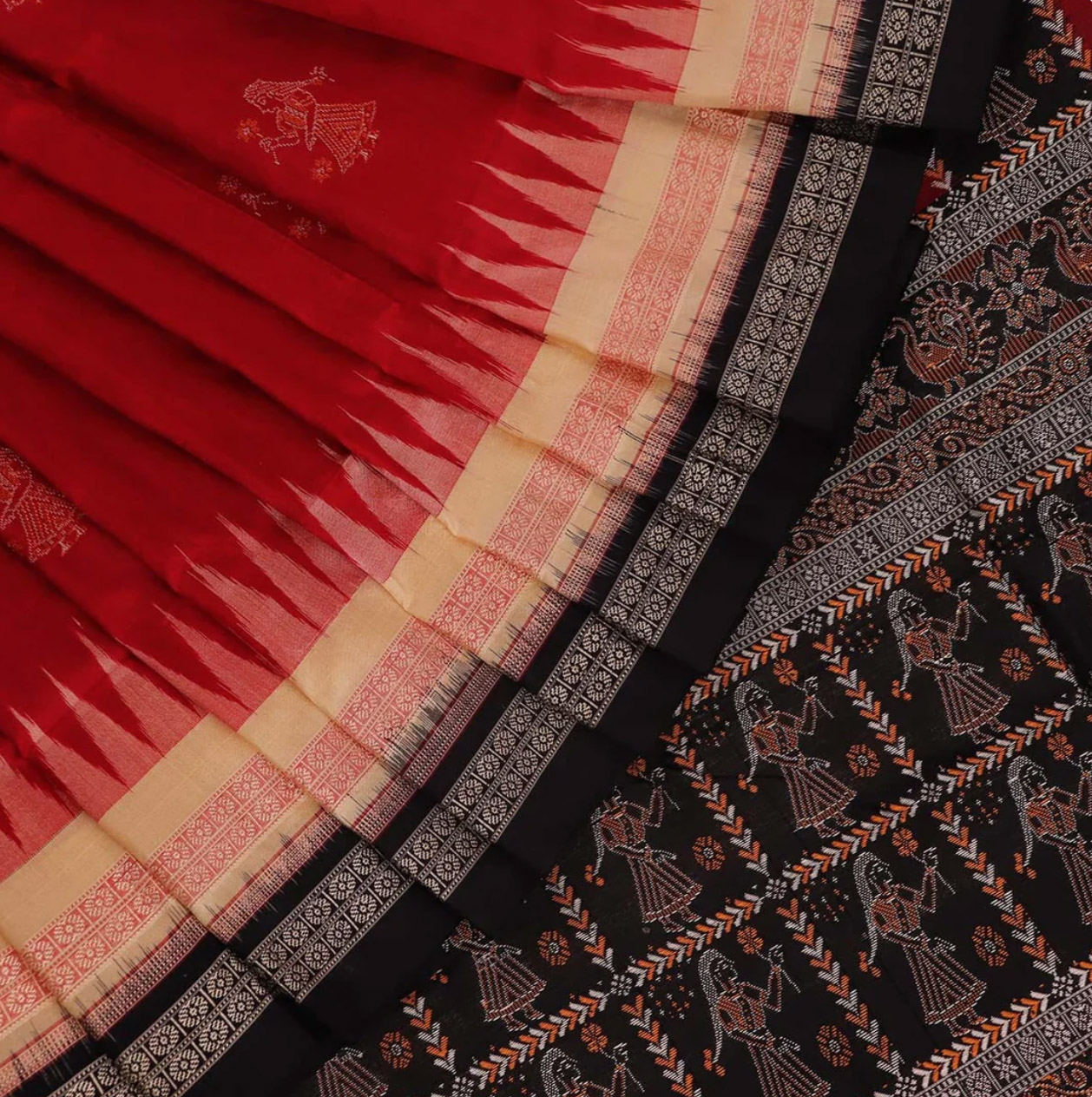
Odisha has one of the finest handloom, textile and handicrafts industry in the country. The handloom tradition has been in practice in Odisha since the fourth century BCE. The long and pristine history of textiles in Odisha is also attributed to the menial exposure of the same to the outside world.
Bomkai Saree
It is also known as the Sonepuri saree, woven in the Ganjam and Subarnapur districts of Odisha. The Bomkai saree is woven on a pit loom using extra weft techniques for intricate motifs and a contrasting border, blending ikat and embroidery effects.
- Motifs: The saree is known for its patterns and motifs, comprising primarily of temple patterns, tortoise, and lotus motifs.
- Colour Palette: Traditionally feature earthy shades like red, black, white, and yellow, accented with vibrant thread work in contrasting bright hues.
- GI Status: Bomkai Silk got its GI tag in 2009
Sambalpuri Ikat
As the name suggests, this ikat hails from Sambalpur, and is known for tie-and-dye ikat patterns and tribal motifs, featuring the rich weaving heritage of the state.
- Motifs: Mainly includes geometric, floral, and faunal motifs.
- Colour Palette: Known for its vibrant colours, the palette includes red, white, blue, green, and black colours.
- GI Status: Sambalpuri ikat was awarded the GI tag in 2006.
20. Punjab

Punjab is renowned for its traditional textile art, Phulkari, featured by the vibrant floral patterns on cotton. Apart from this, the other textile tradition in the state is that of Khes, which is characterized by handwoven patterns of bedspreads and shawls.
Phulkari
Literally, phulkari means ‘Phool’ and ‘kari’, that is, ‘floral work’. This iconic embroidered textile from Punjab has become a cultural symbol for the state over the years.
- Motifs: The motifs include floral patterns, and peacocks.
- Colour Palette: The palette is vibrant with red, pink, orange, yellow, and green colours, symbolizing energy, and good vibes.
- GI Status: It was awarded with the GI tag in 2010
21. Rajasthan

Rajasthan is a hub of cultural endevours. The state is known dor its blue pottery, marbles, miniature paintings, and brass traditions. The handloom tradition is another cultural art being practiced and mastered in the state for centuries. The three most famous handloom traditions are:
Bandhani
The most intricate feature is the mirrored pattern and bright colour palette. The Bandhani odhnis and turbans make up the traditional festive and wedding attire in Rajasthan. The features are similar to that of the Bandhani handloom of Gujarat.
- Motifs: Bandhani patterns include dots, waves, squares, and floral designs created through intricate tie-dye techniques.”
- Colour Palette: The palette ranges from vibrant reds, yellows, blues, and greens to traditional combinations like red & yellow or black & red.
- GI Status: Rajasthan and Gujarat received the Geographical Indication (GI) tag in 2009
Kota Doria
This handloom is known for its airy and breathable texture, making it a popular choice for comfortable attire, blending conform with elegance.
- Motifs: The handloom has a checkered weave with khat or square patterns and zari embroidery.
- Colour Palette: It has pastel hues like pink, blue, and white, combined with festive colours like red and golden.
- GI Status: TheKota Doria textile was given the GI tag in 2005.
Shisha
Another common handloom in Rajasthan and Gujarat, Shisha embroidery is one of the most famous handlooms of India. The main work is done by mirror pieces, as suggested by its name. Nomadic communities of Rabaris and Meghwals adorned shisha embroidery traditionally using herringbone, chain, or satin stitches.
-
Motifs: Shisha embroidery uses mirrors set within geometric and floral motifs symbolizing protection and vibrancy.
-
Colour Palette: It features a bright palette of reds, yellows, greens, and blues contrasted with white or black for striking visual appeal.
22. Sikkim
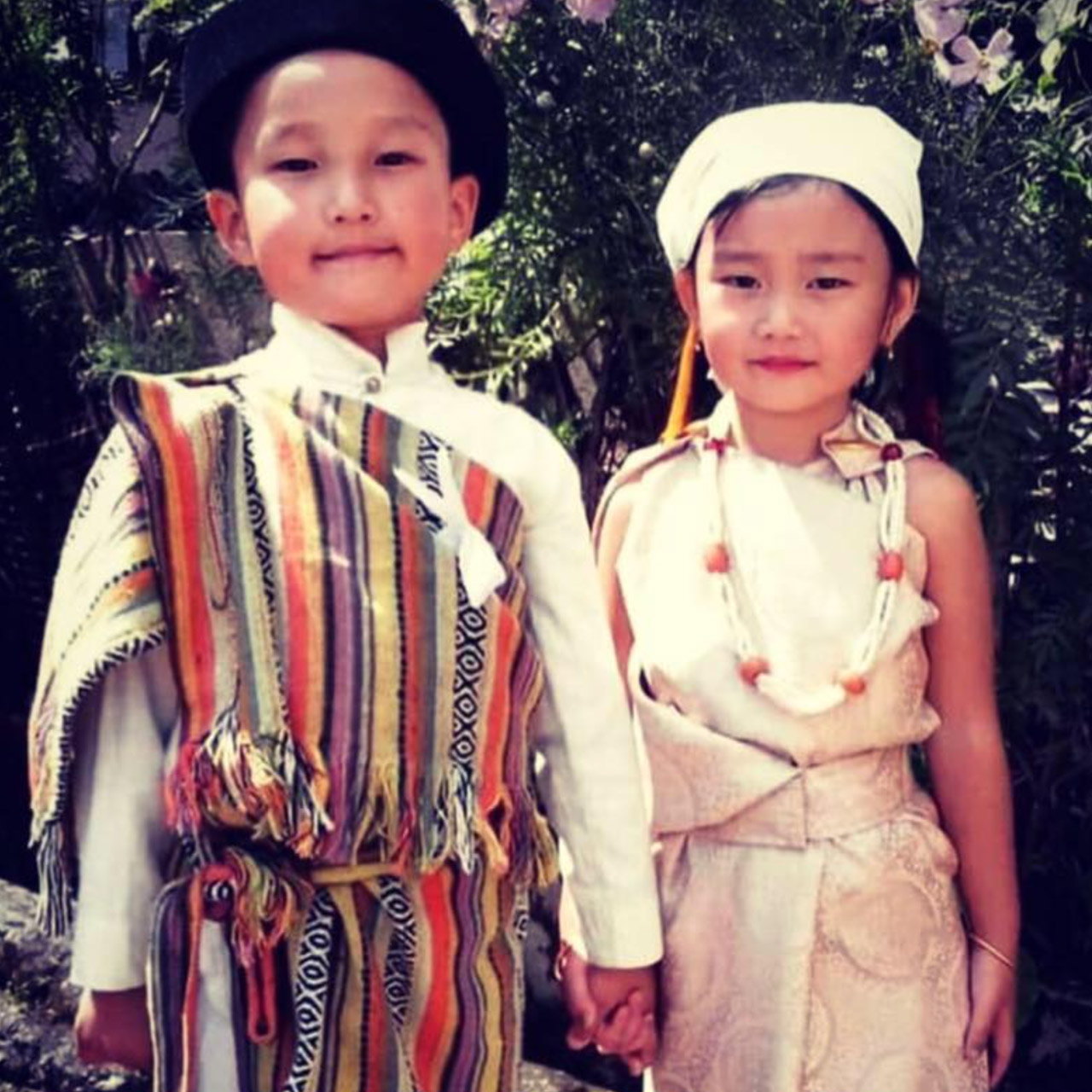
The handloom tradition of Sikkim consists of woolen and cotton weaves like Thara and Lepcha shawls. The textiles, prepared by the tribal communities in the region, reflect the influence of the Himalayan culture.
Thara and Lepcha Weaves
The Thara and Lepcha shawls are woven predominantly by the Bhutia and lepcha women. These shawls are known for their detailed patterns and are ideal for cold temperatures. While Thara is known for colourful stripes, Lepcha has detailed tribal symbols.
- Motifs: The common motifs include geometric patterns and Buddhist-inspired motifs.
- Colour Palette: Red, blue, green, white, and muddy tones.
23. Tamil Nadu
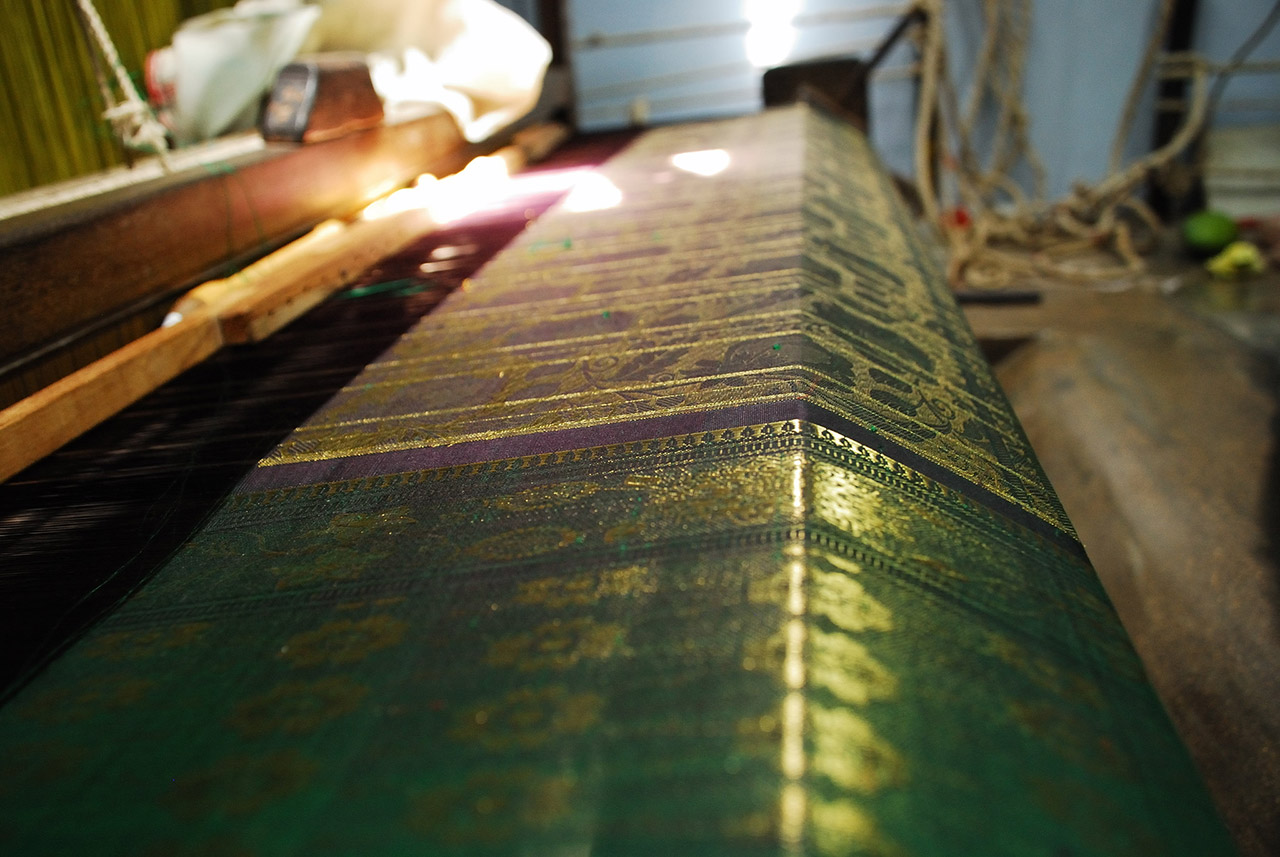
Tamil Nadu is famous across the country for its beautiful sarees and other elegant textiles. These are known for their beautiful and vibrant colours, detailed designs and high quality. The most famous handloom tradition is that of Kanjeevaram, while other notable traditions include Bhavani Jamakkalam, Devendra sarees, and Korrainadu sarees.
Kanjeevaram Silk
The Kanjeevaram silk, from the town of Kanchipuram, is renowned for its texture and patterns, inspired by temple motifs. It is made from pure mulberry silk with silver zari, each saree takes around 10-20 days to complete.
- Motifs: Checks, stripes, mango motifs, and South Indian mythological narrations
- Colour Palette: Bold colours like maroon, gold, emerald, and crimson.
- GI Status: Awarded the GI tag in 2005, representing South India’s finest quality in silk weaving.
24. Telangana
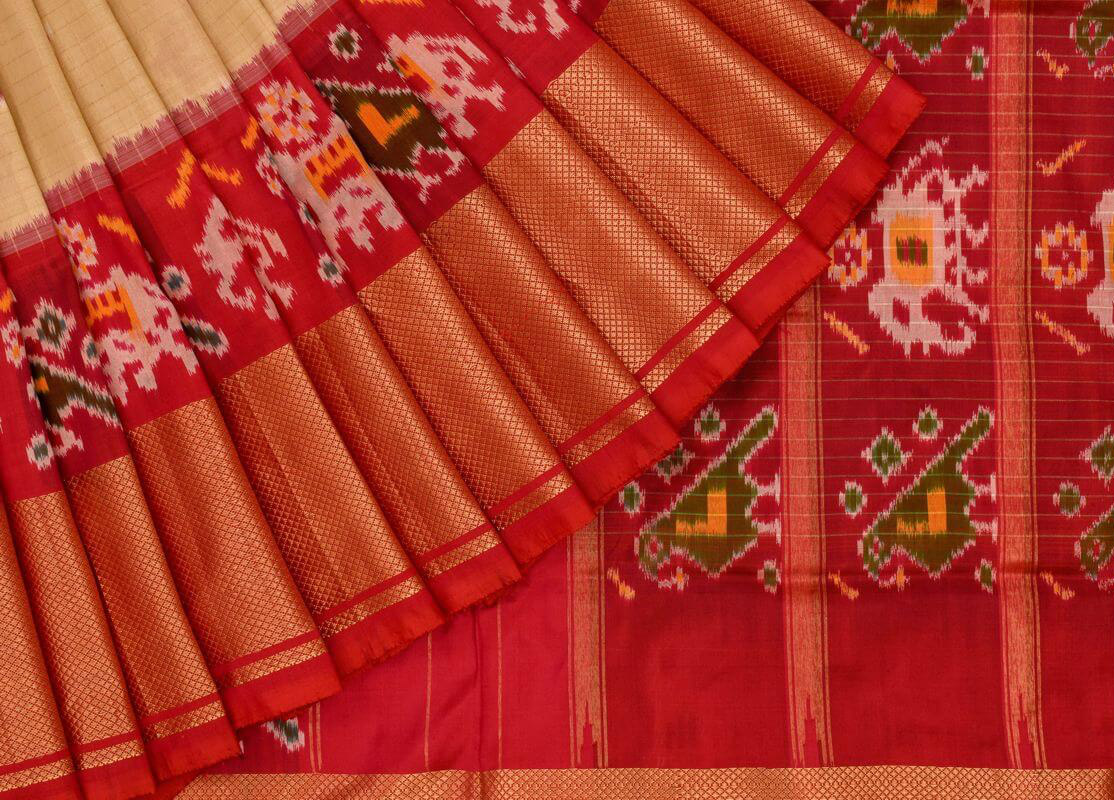
Telangana is often associated with the best ikat weaving. The sarees of Telangana are popular amongst the women of the entire Indian subcontinent. The most famous handlooms of Telangana include Pochampally sarees, Gadwal sarees, and Narayanpet sarees.
Pochampally Saree
Hailing from Bhoodan Pochampally village, the Pochampally saree is known for its resist-dyed geometric patterns, in both single, as well as double ikat.
- Motifs: The most prominent motif designs include diamond shape, chakra, and stylised bird motifs
- Colour Palette: The palette is either in classic red-black-white palette, or in modern pastels and neons.
- GI Status: With over 10,000 weavers associated with the handloom, it received the GI tag in 2005.
25. Tripura
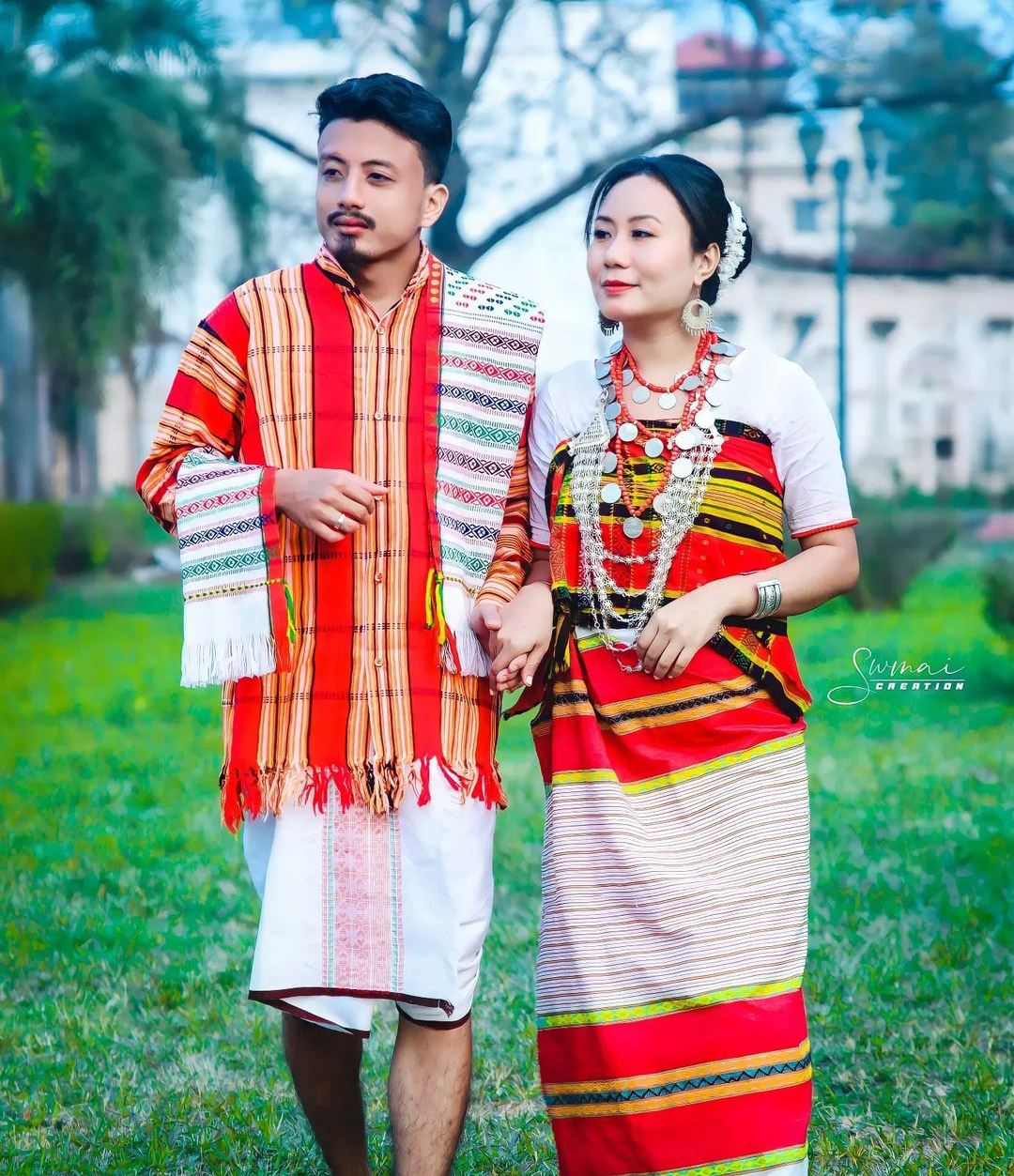
The handloom tradition of Tripura is rooted in its tribal cultural identity, The designs and motifs represent the tribal identity. The most popular ones are Risa and Pachra, however, the handloom tradition of Tripura includes functional and decorative items as well.
Risa and Pachra
The tribal communities like Tripuri, Reang, Chakma, and Halam are attributed with the craftsmanship of Risa and Pachra. These are sustained in the regions like Agartala, Kailasahar, and Belonia. This is a women-led industry and is integral to the cultural identity of the state.
- Common Features: Risa is a handwoven scarf, worn as a headgear or to cover the chest, while Pachra is the lower garment worn by women, paired with Risa.
- Motifs: These fabrics are woven with vertical or horizontal stripes and motifs like dots, stars, flowers, or tribal symbols.
- Colour Palette: Vibrant colours like red, white, green, blue, and black are used predominantly.
26. Uttar Pradesh
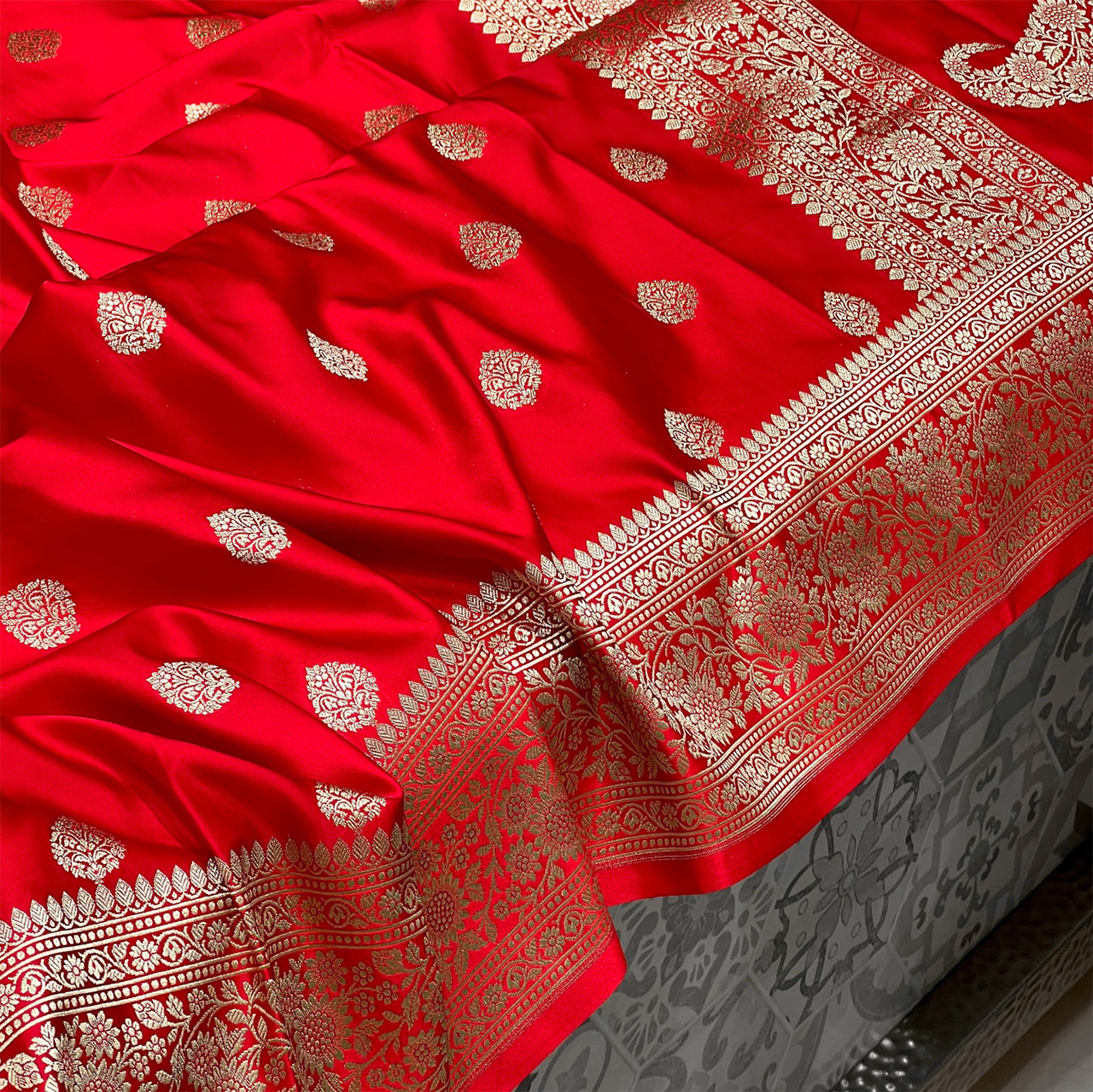
Uttar Pradesh is known for two things- its food, and handlooms. The state is particularly famous for the Banarasi silk and Chikankari embroidery. It is known worldwide for its high quality and intricate designs.
Banarasi Silk
Woven from pure mulberry silk with gold and silver zari work, the GI-tagged Banarasi Silk is known for its Mughal-inspired brocades and intricate motifs. It has an elaborate procedure that takes at least three artisans and 5,600 thread wires to weave one saree, taking up to 6 months for the final product.
- Motifs: Kalga, bel, jhallar, along with minkari works.
- Colour Palette: Banarasi silk sarees shine in jewel tones like red, blue, green, and purple, enhanced with luxurious gold and silver zari.
Types: There are four main types of Banarasi sarees:
- Katan: made from pure silk
- Organza (Kora): lightweight silk with silk and zari work
- Georgette: crepe fabric with crinkled texture
- Shattir: woven with detailed patterns
- Other styles of Banarasi silks include Jangla, Tanchoi, and Buitidar.
Chikankari
Chikankari is one of the most famous handlooms across the Indian subcontinent. Chikankari is a hand-embroidery textile. It hails from Lucknow, Uttar Pradesh, and is traditionally adorned on cotton or muslin cloth. The handloom was under patronage of Noor Jahan during the 17th century, and was known for being influenced by Persian and Indian art. The designs are made by needlework, and are completely made by hand. The signature stitches include:
- Taipchi (running stitch)
- Bakhiya (shadow work)
- Murri (satin stitch)
- Phanda (knot)
- Jali (openwork lattice)
- Motifs: The motifs are inspired by Mughal art, nature, and geometric designs.
- Colour Palette: The traditional palette comprises of white-on-white embroidery, however, it is not available in various colours.
- GI Status: It was awarded with the GI tag in 2008.
27. Uttarakhand
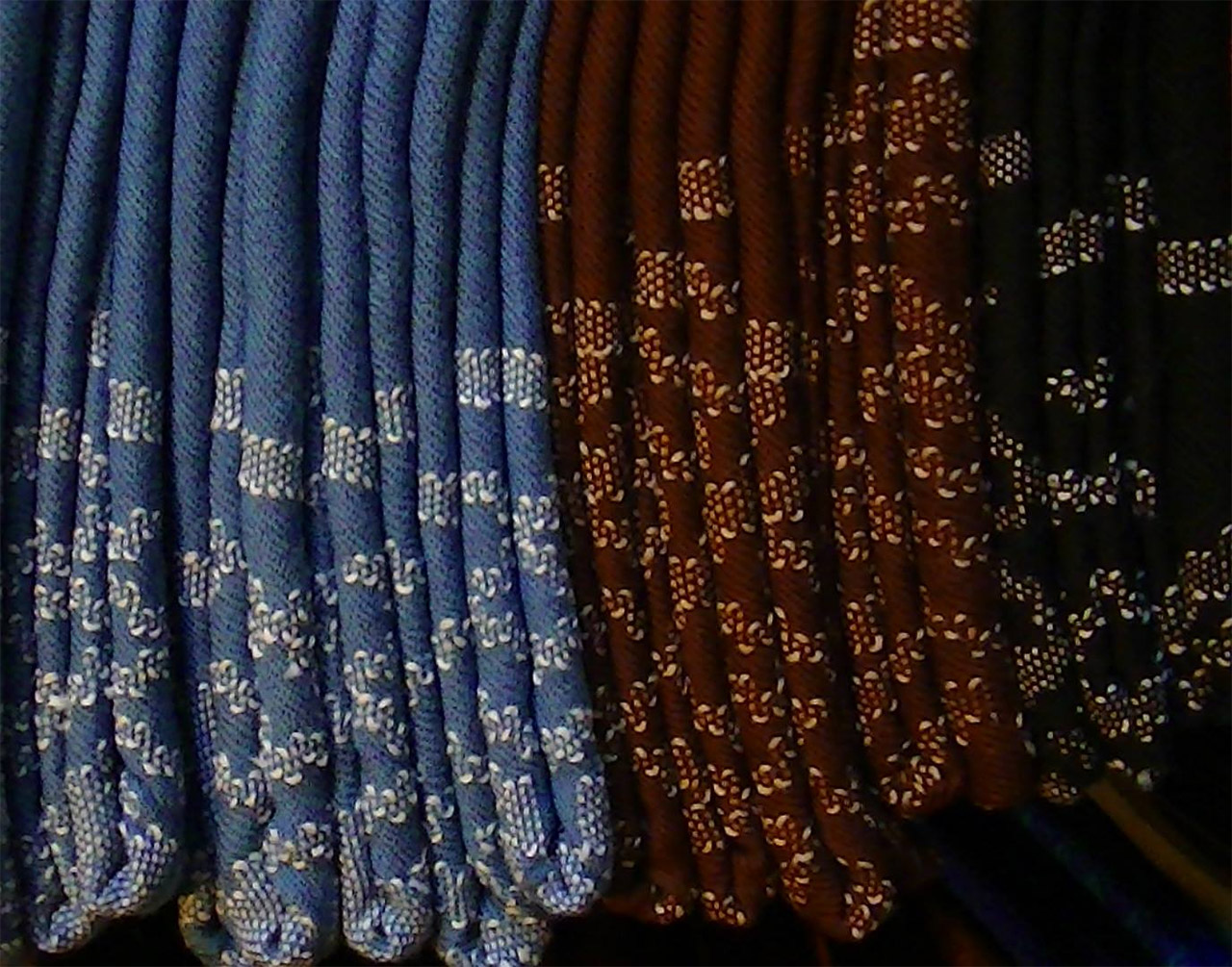
The handloom tradition of Uttarakhand is rooted in the Himalayan culture of the communities residing in the region. The textiles are woven by women and Bhitia weavers, and are known for being inspired by the beautiful landscapes of the region and the tribal heritage.
Panchachuli Weave
These handwoven shawls and stoles are inspired by the Himalayan landscapes, and are adorned with detailed patterns. High quality Pashmina is used for these shawls. The dyes was the yarn are usually plan-based and eco-friendly.
- Motifs: The motifs reflect the mountains, peaks, flowers, geometric patterns, and the mountain majesty.
- Colour Palette: The colour palette involves subtle earth tones like white, beige, and grey, and are enhanced with accents of red, green, and blue.
28. West Bengal
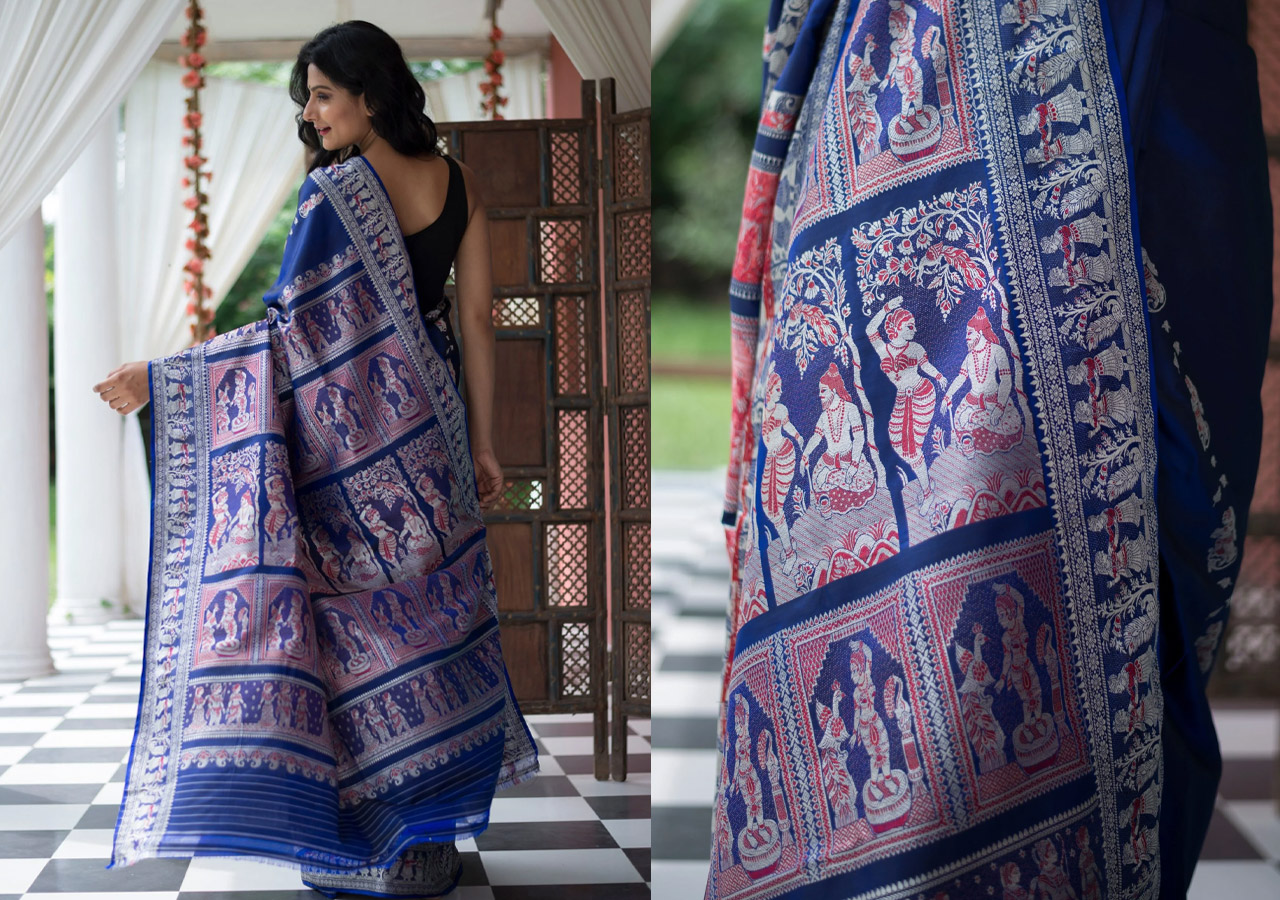
West Bengal has a wide range of handloom traditions associated with its name. The most popular handloom of Bengal is the Bulcharu silk, however, the handloom tradition in the state is not limited to just one silk. The other notable Bengali textiles of prominence include Jamdani, Dhakai, Tangail, Begumpuri, and Dhaniakhali.
Baluchari Silk
The Baluchari Silk sarees are associated with Murshidabad and several revival efforts since then have turned this handloom craft into an art form, presented vividly in museums. The Baluchari Silk was under the patronage of the Nawab during the 18th century.
- Motifs: Scenes from Ramayana and Mahabharata, and even from the colonial period are depicted via motifs on Baluchari silk sarees.
- Colour Palette: The palette includes regal colours like red, purple, navy, and gold.
- GI Status: The Baluchari silk sarees were awarded with the GI tag in 2009.
Jamdani
This muslin-based fabric textile is known for its ornamental designs, created using weft technique. It originated in Bangladesh and West Bengal around the 2nd century BCE. The handloom tradition emerged and flourished during the Mughal era, particularly in Dhaka and Nadia.
- Motifs: The prime motifs include paisley, floral designs, and stars.
- Colour Palette: The palette includes soft tone colours like white, beige, and other pastel shades, accompanied by the vibrant accents of red and green.
- GI Status: The GI tag was awarded in 2016.
Significance, Challenges and Revival
The greatest challenge to the India handlooms was posed by the emergence of power looms during the era of globalisation. The competitive prices of the machine-made or replicated designs cannot be matched with the intricate and unique designs and techniques associated with the handlooms.More than 10 lakh workers across the nation are engaged in Indian Handlooms at present. The textile exports are economically significant for India, contributing about $33.75 million (2022-23).
Several steps and initiatives have been taken up by the Government to revive and support the handlooms of India. These include introduction of schemes like the National handloom Development Programme, the Raw Material Supply SCheme, The Weaver’s MUDRA scheme, etc. Further, over 106 handlooms have been awarded with the GI Tags, ensuring their authenticity, and to boost their national and international recognition.
FAQs about Handlooms of India
Question: Which is the handloom capital of India?
Question: What are the different types of handlooms?
Question: Which handloom is famous in India?
Question: Which is the saree capital of India?
Question: Which is the biggest weaving village in India?
Few Lines on Indian Handlooms
- Indian handlooms boast a glorious heritage dating back to ancient Indus Valley Civilization.
- Every Indian region contributes differently towards the rich world of handwoven fabric.
- British colonial policy ruthlessly affected India’s thriving handloom industry.
- Mahatma Gandhi’s ‘khadi’ movement popularized handlooms as an image of self-reliance.
- The Khadi and Village Industries Commission (KVIC) promotes handloom revival.
- Paithani, Bandhani, and Mysore Silk are some of India’s lovely handloom heritage.
- Even with modern power looms, the unrivalled brilliance of handlooms remains celebrated.


